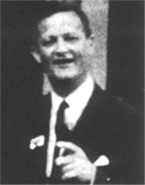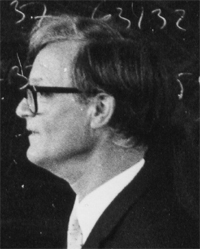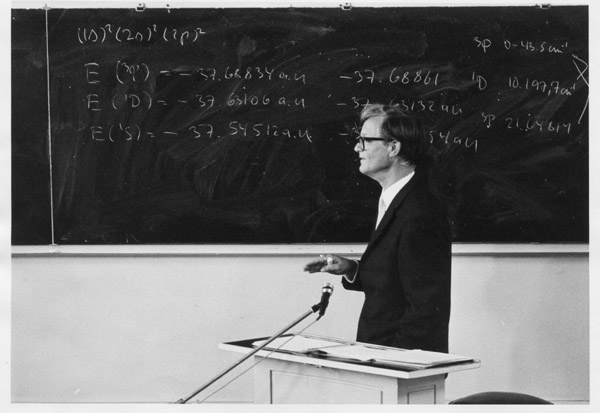



Ballhausen around 1979 Photograph: © J. Chem. Ed. 56, 215, 1979. |
Carl Johan Ballhausen was born in Copenhagen in 1926 and
graduated in 1954 with a mag. scient. degree (equal to a Ph.D.)
from the University of Copenhagen
in inorganic chemistry. He received his dr. phil.
(about equal to a German 'Habilitation', based on a
publication of additional and intensive scientific research) at
the University of Copenhagen in 1958. Ballhausen continued
his career as an
Assistant Professor at the University of Chicago
that same year. Ballhausen has been a postdoctoral fellow at Harvard University and a visiting scientist for Bell Telephone Laboratories in Murray Hill, New Jersey. Ballhausen, starting with Bethe's crystal field method in the 1950s, developed from there a theory for transition metal ions which became known as Ligand Field Theory. This work led rapidly to detailed correlation of both the electronic spectra and the magnetic properties with the structures of transition metal complexes. Ballhausen's work resulted in many papers and his well known book Introduction to Ligand Field Theory in 1962. In 1992 Ballhausen, among many other acknowledgements he had received, was elected Foreign Associate Member of the National Academy of Science, USA. |

Ballhausen in 1972 Photograph: Courtesy and © J.P. Dahl,Kopenh. |
| Carl J. Ballhausen List of Publications |
| Get it short, good and fast: Carl J. Ballhausen : History of the Crystal Field Approach. From: Introduction to Ligand Field Theory. |
The article : View |

| Carl J. Ballhausen :
Introduction to Ligand Field Theory.
McGraw-Hill, New York, 1962. |
Some pages for an impression and, as an extension, a longer part so that one can see what had been done in inorganic chemistry up to 1962 - with 435 references. View |
| Carl J. Ballhausen :
Quantum Mechanics and Chemical Bonding in Inorganic Complexes.
J. Chem. Ed. 56, I : 215-218 II : 294-297 III : 357-361 (1979). |
It is this article to which Ballhausen categorically refers to
when asked about Ligand Field Theory : View I View II View III |
| J. P. Dahl, C. J. Ballhausen :
Molecular Orbital Theory of Inorganic Complexes.
Adv. Quant. Chem. 4, 170-226. (1968) |
When Ligand Field Theory had to give way to Molecular Orbital Theory : View |
| Video clip. | Dahl talks about his interaction with Ballhausen. (5 min). | MPEG4; 8 MB | There is still the problem concerning codecs and Microsoft. Especially with IE6 and Win Media Player: Under certain browser settings of IE6 that may got as far as: "File not found on the server." - it's there of course. Sad but true - the codec fight carried out on the back of the user! If you know what you are doing just go into regedit and kill the connections. | in English |
| Video clip download. | Dahl talks about his interaction with Ballhausen. (5 min). | ZIP of MPEG4 of the above; 5.5 MB | While IE6 now apparently ckecks all files as to their contents before downloading (see above) them, it so far (May 2002) doestn't dare to do this to ZIP files. Which means that you can download it, unzip it, and then view it. I found out that this presently is the best way handling MPEG without the threatening behaviour of Microsoft and IE6. | in English |
| Sound clip | Dahl talks about his interaction with Ballhausen. (5 min). | WAV; 3.5 MB | The sound-only track of the above videos. | in English |
| Sound clip | Dahl talks about his interaction with Ballhausen. (5 min). | MP3; 730 KB | Maybe here the same trouble with IE6 and the Win Media Player. | in English |
| Text of the above. | Dahl talks about his interaction with Ballhausen. | HTML | in English |
